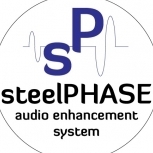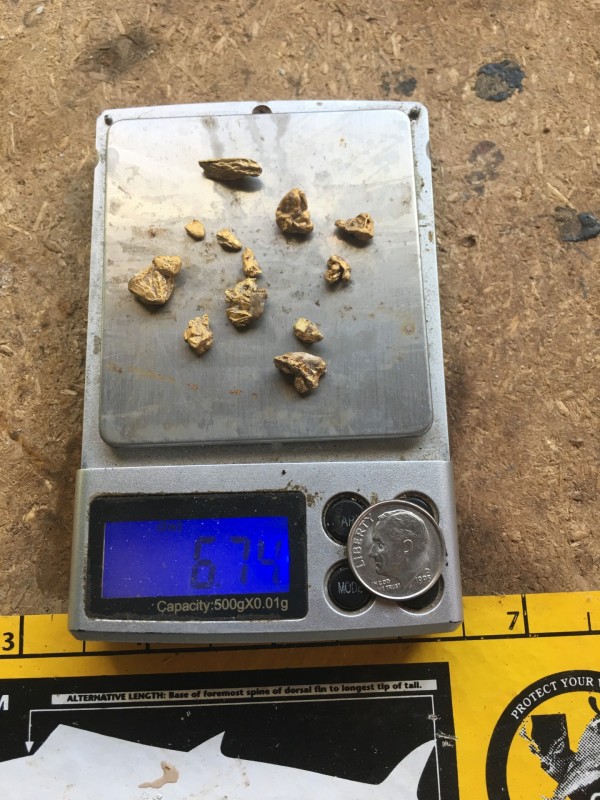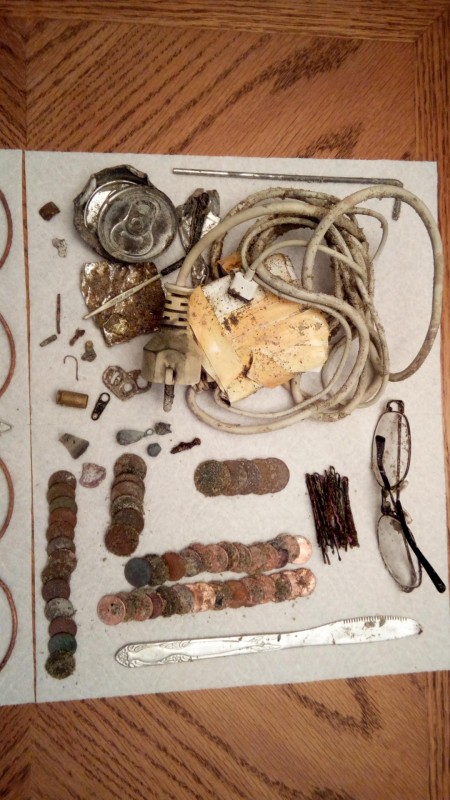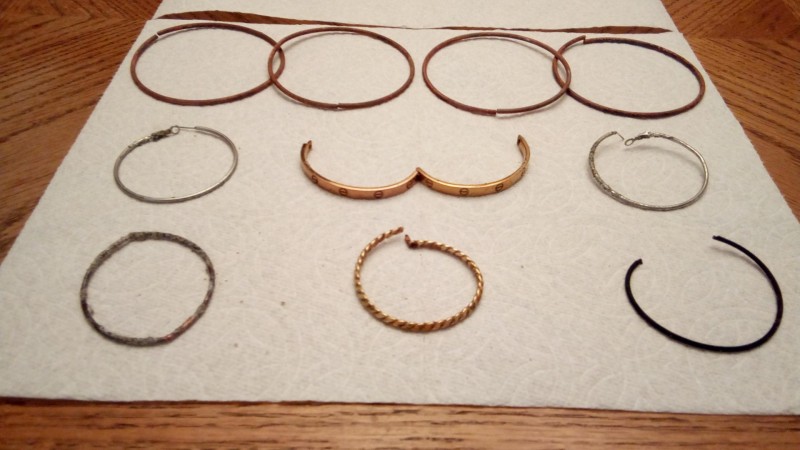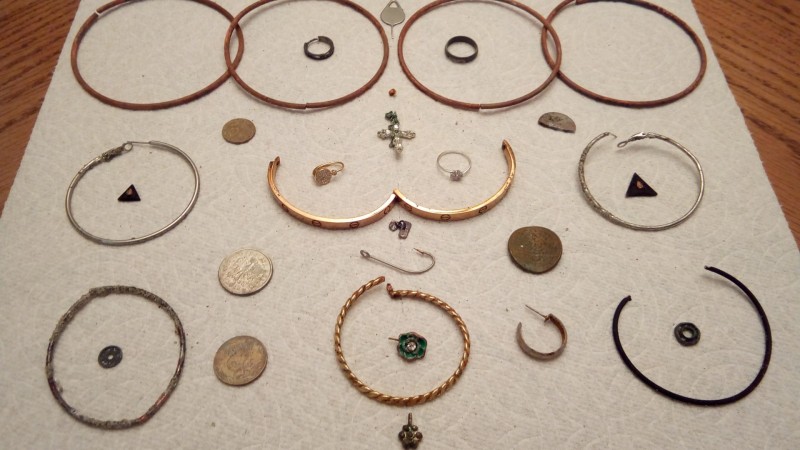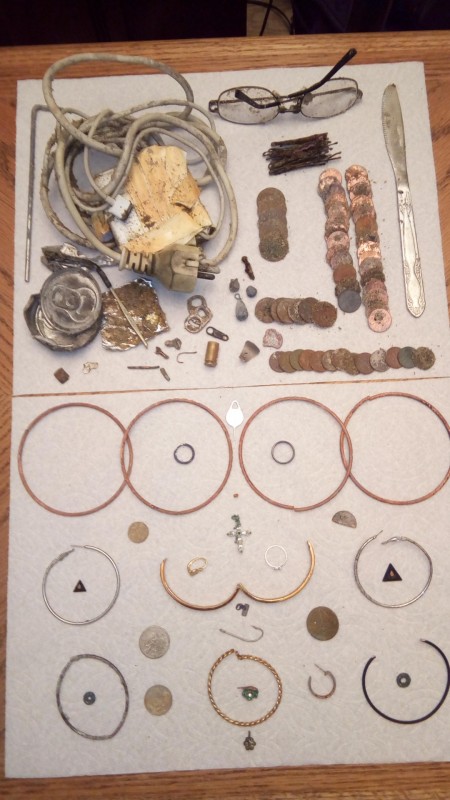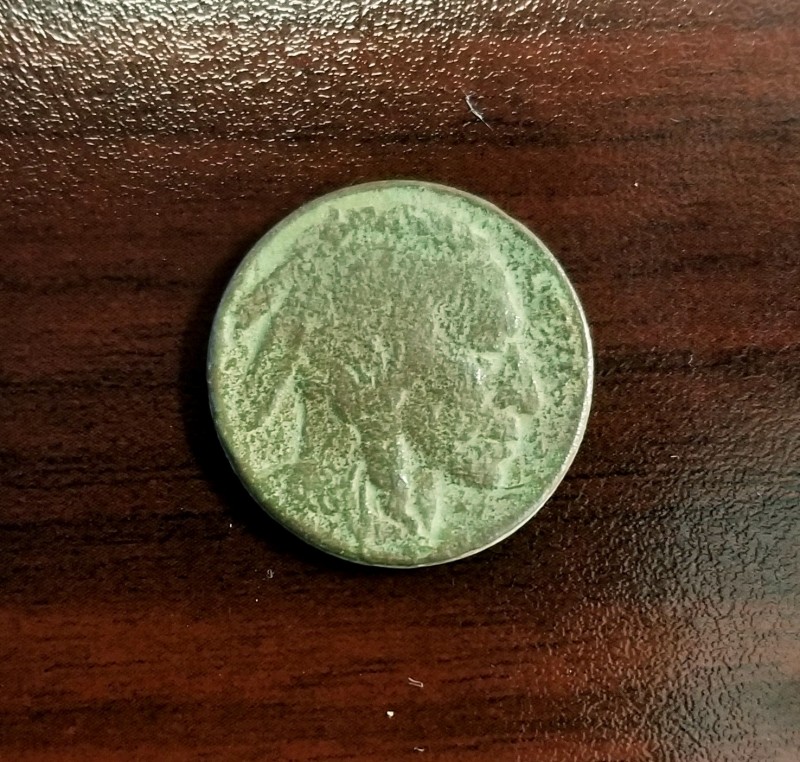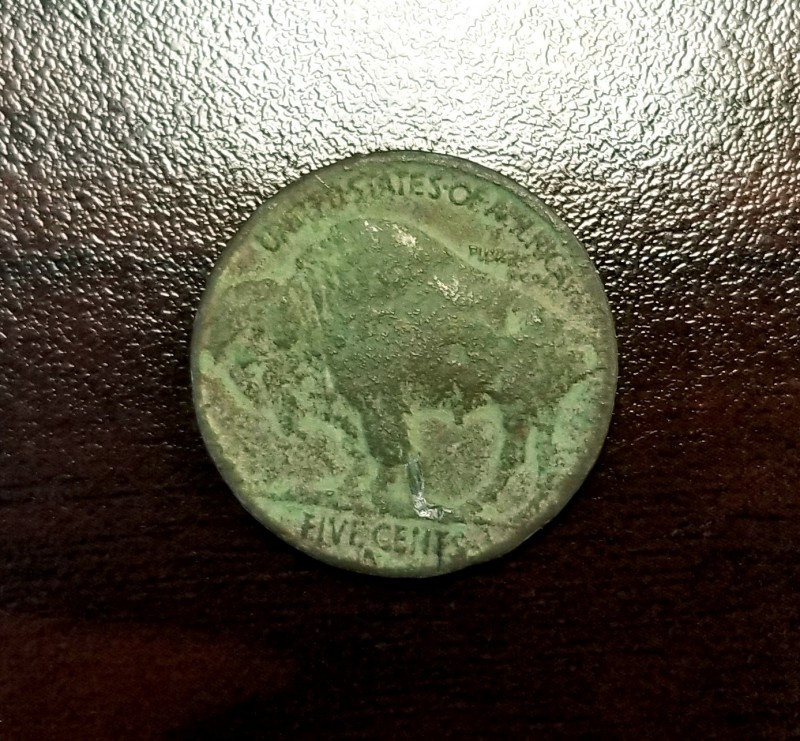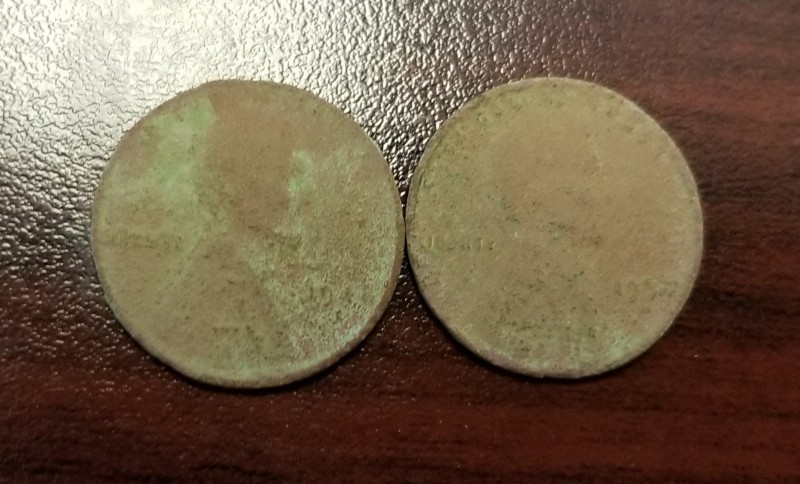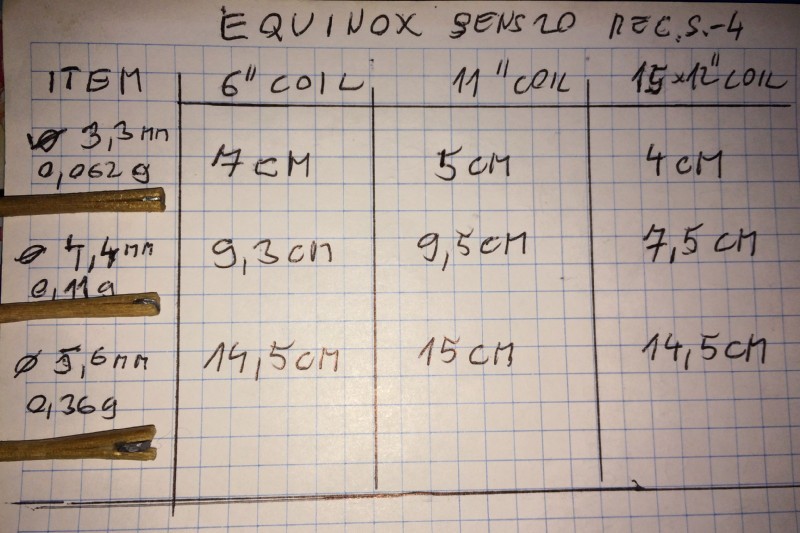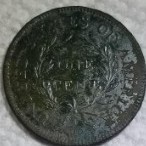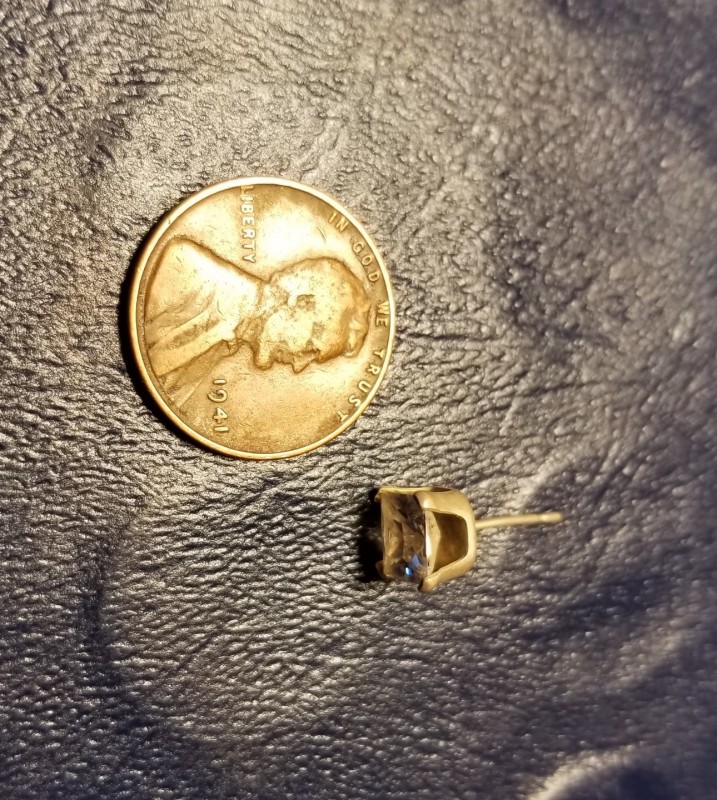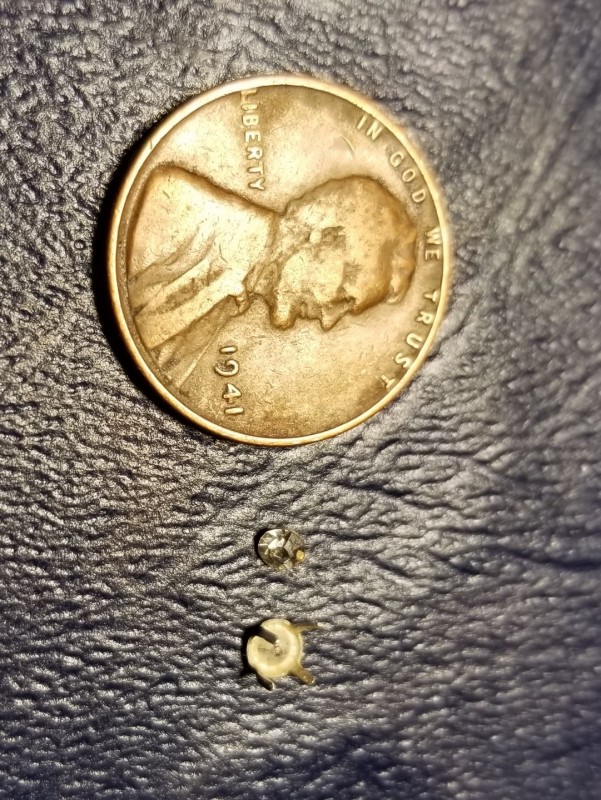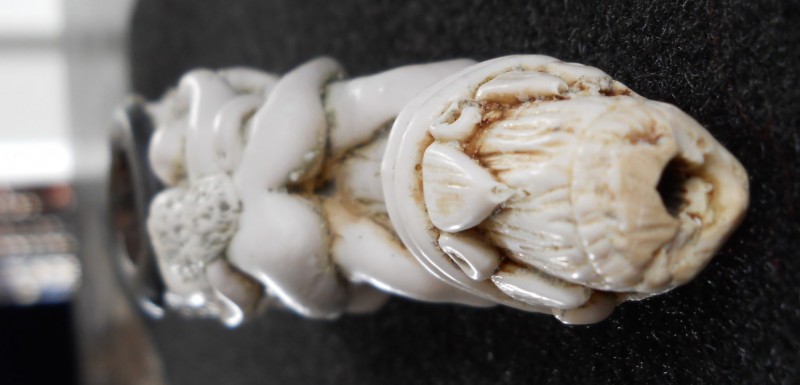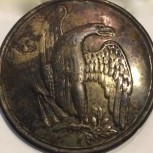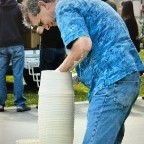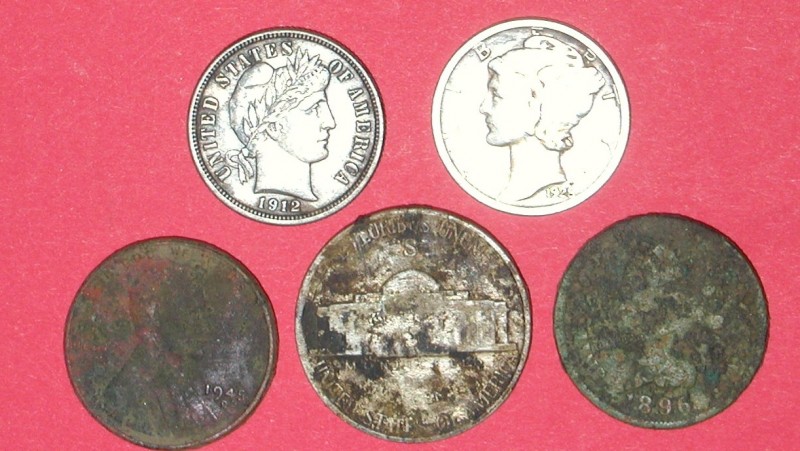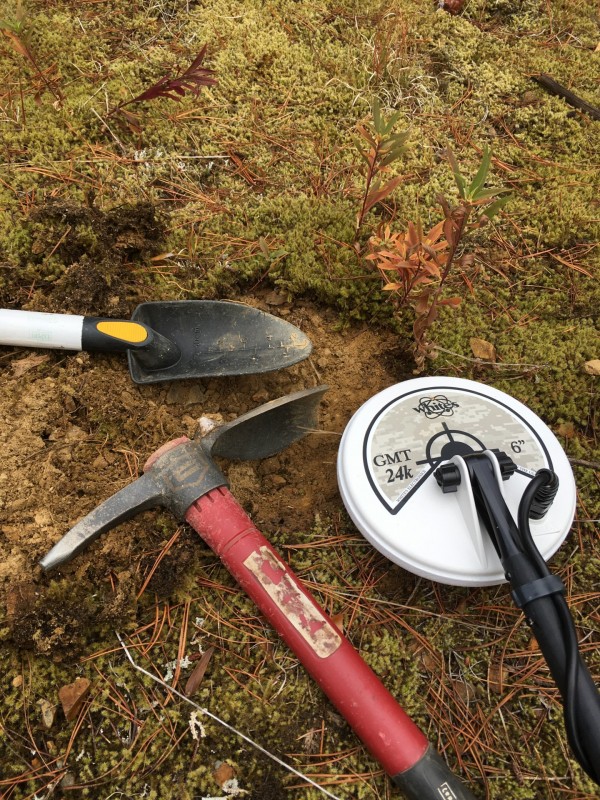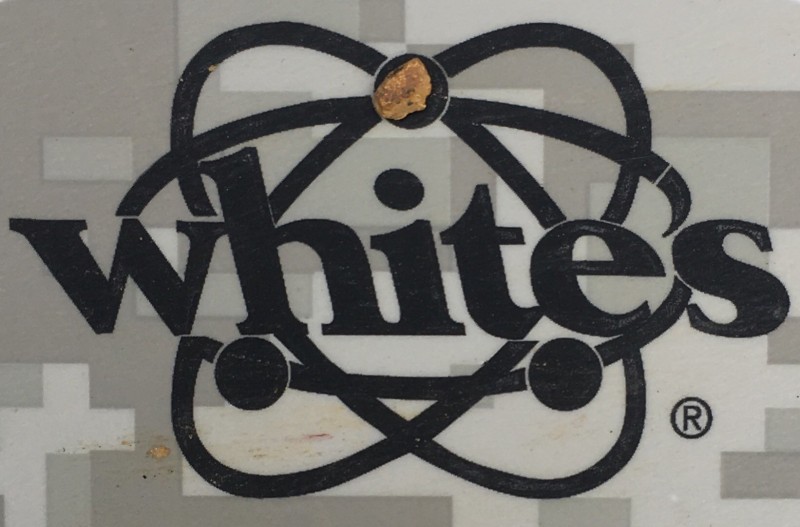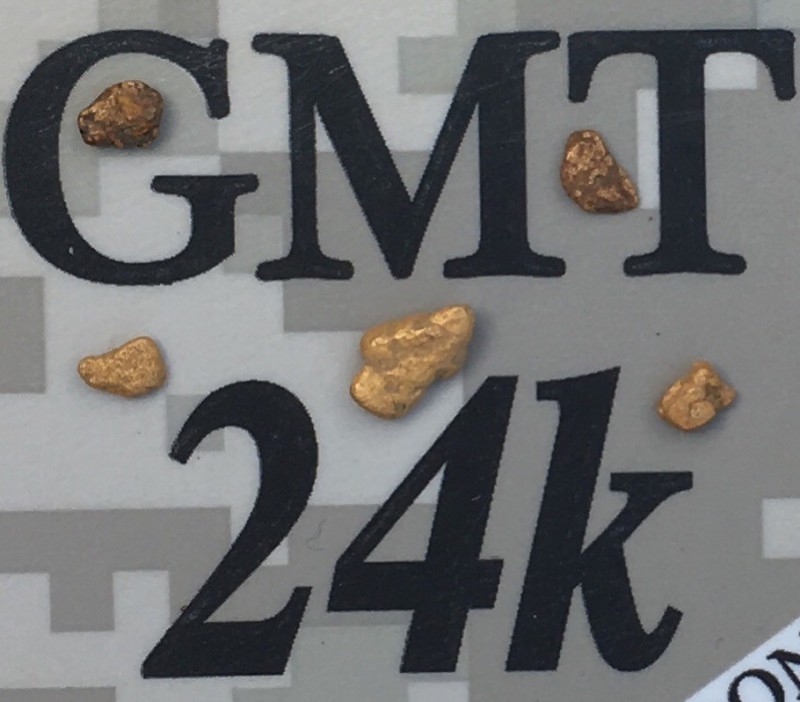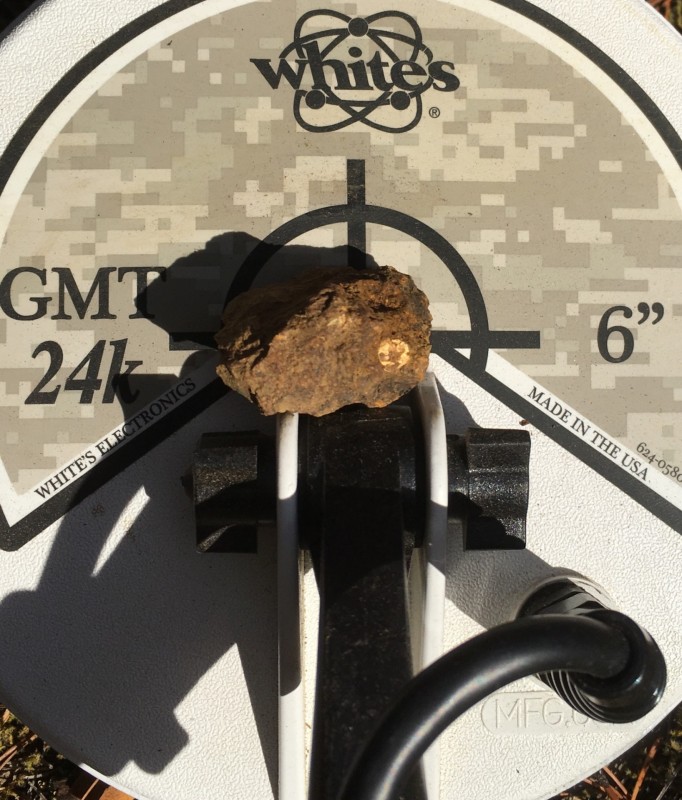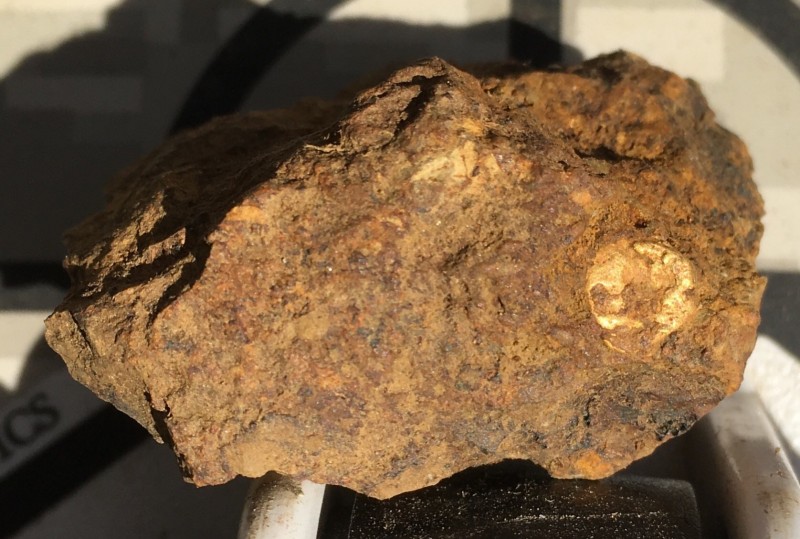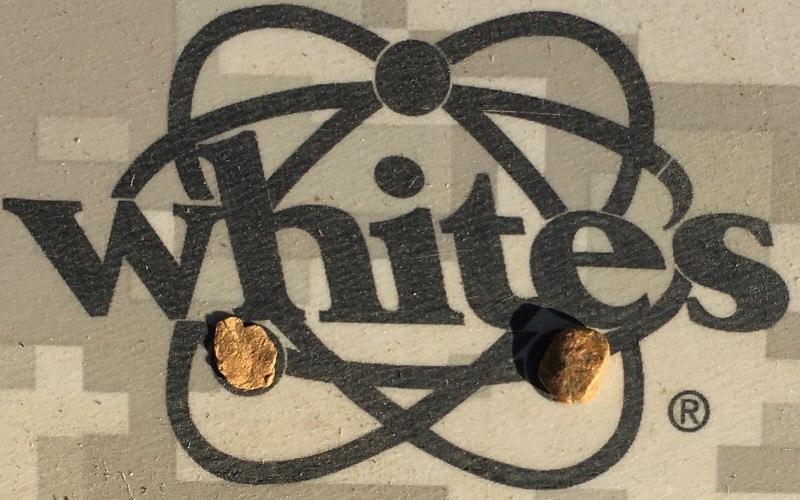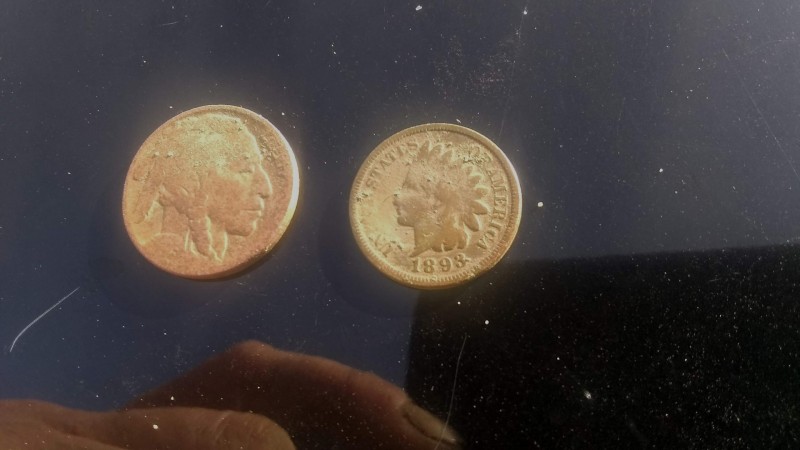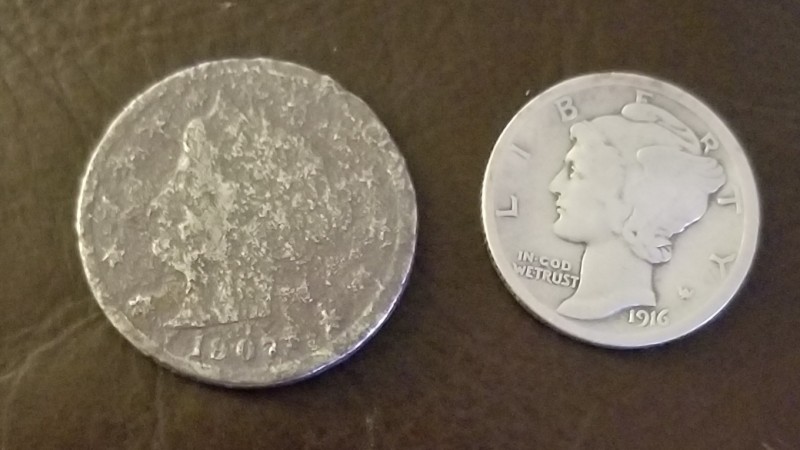Leaderboard
Popular Content
Showing content with the highest reputation on 10/17/2018 in all areas
-
Years ago, when I started to hunt Rye Patch I knew it was well past it’s hey days! Yet, I continued to see nuggets being found there by others Prospectors! Our group, finally started to pop some gold after wearing out several sets of boots and skid plates on our old trusty GPX’s. With the new generation of Minelab Detectors, SDC 2300 and the GPZ 7000, it was a new game. Having cut our teeth on the learning curve of both new detectors on the California side of the hill, we set our sites to Northern Nevada. Multitude of hours by our group to establish productive ground and techniques with our GPX’s, lead our new detectors to what seemed like brand new patches of gold. This last outing was no different! One of our hunting members had a moment of Total Recall and remembered a few years back that we found a few nuggets in a spot with our old GPX’s. Well we hit the spot swinging and soon our detector’s started to sing back to us! Now remember, I was out there a couple weeks ago, trying to track down a couple new spots for this group hunt trip. I didn’t find any new spots on that trip and we didn’t even hunt the old spots on this trip, which I did good on. Now, there is only one way to run the SDC and that’s turn it on, it’s and incredible detector and the operators of it on this trip pulled teens of nuggets with it. But, you have to know the variable sounds of the SDC when you run the coil over a target that set you apart from others swinging the same machine over the same dirt. It’s the same with the GPZ 7000, you really can’t run it wrong, just turn it on! You make it run for you and your inner self. Sure I have settings, I like and so does everyone in our group of Prospectors. You have to know what it’s telling you if it’s a target or not, there isn’t many Duck nuggets left in any old gold field(s). Air testing or burying a test nugget does not reproduce any of these nugget signals (tones). I’m still learning tones of the GPZ and will never be and expert of them. The sweet tones of a nugget, I do have lock in my mind is what keeps me and boot makers happy! Lucky...No - spend the time in your local gold field, might take a few pairs of boots, skid plates and multitudes of digging holes in hot ground and rocks to learn the tones of your settings of your detector. We had a great time, even though the wind was crazy windy and made Detecting a challenge - Persevere, press on regardless! Until the next hunt Here’s Robin’s and my 2 1/4 day hunt total in dwts8 points
-
This was my first beach hunt in a few days because I had been out in the Rye Patch area over the weekend. While I was gone I understand that it had rained and some wave alerts had been sent to my email. Our area beaches get hit hard by detectorists but I know them pretty well and followed my intuition when I got there. We don't have a negative tide right now and there is a Santa Ana wind blowing so the new waves are very small. On my way 'out' I hunted near the waterline. There was very little to find. I walked about a mile or so with very few targets. There was a bit of a trough at the bottom of the hill (beach slope) but nothing seemed to be holding. I was thinking about leaving and I worked back in the direction from where I had come. Then I got a clue. The clue was the junk wire pack. It was completely buried in the wet sand and had a thin plastic bag around it. It certainly is an unusual beach find for me. This pack was at the bottom of the hill and just above it for about 6 feet or so was hard sand and just above that was about 10 yards of 'past wave' deposited sand. You need some energy to move targets and you need the right conditions for those targets to be 'grouped' and deposited. Some beaches will stay this way for a few days and some beaches will only keep targets for a few hours. I look for these pockets. I liken it to a crab crawl on the Deadliest Catch. Anyway, I went up into this area and found a hoop earring among the bobby pins, pennies and a few other coins. I was using the Nox 11 on all metal and I was digging EVERYTHING. Sometimes I skip pennies and bobby pin sounds but not last night. Then I was surprised by one of the silver hoop earrings and its mate was just about 5 feet away. Then came a copper hoop, and then another and all of them within 10 feet. They're all water tarnished. Then I got what I thought was a ring ... earring it turns out but then a stainless steel bracelet. Then another earring (GOLD) and finally a couple of silver rings (.925). I worked the patch with a grid pattern and it kept giving. I had had enough after 4 hours. A 'bad' beach had turned into the most hoops (10) I've ever found. I've been on beaches where I've found 5 chains in a session but they are as rare as this beach. You never know. Follow your clues. Mitchel4 points
-
Just returned from Gold Basin, lots of trash , small stuff but no gold. I was not the first to hunt this area s there was lots of unfilled holes...not as many now...still learning the machine. Most of all , I HAD FUN AND IF THE WIND HAD NOT PICKED UP I might still be there.4 points
-
I too have found gold on several of GPAA claims. That being said, part of dues the money goes to fight the fight with the bureaucracy to keep public lands open to small scale mining. As a bonus, you get a detailed book of maps with the GPAA claims. Some of the claims may well be worked out, but it will put you in the areas that have gold. Do your own research from there. Norm4 points
-
Not particularly cleaner. But instead of tone+dead hits I get high-tone+low-tone hits which I find are easier to register. Further, I can hear nearby iron tones and I also can pick up when iron tone and high tone are co-located, such as what you sometimes get with nails. I know some people who use discrimation (threshold in particular) will switch that off when they get an iffy signal, but I just find it easier & faster to keep it off in the first place. In high trash I've gotten false high tone hits halfway between two iron hits. Maybe there are ways to figure this out when threshold discriminating. Another thing I sometimes do is to dig up the offending iron hit in order to get a better location for the good hit (and often that clears up the TID of the good hit). Knowing there is something nearby from the start makes it easier for me. I really don't have much experience running discrimination except for back in the old days when there wern't multi-tones (Garrett Groundhog in my case). I just got comfortable listening for all tones when I learned to detect with my Gold Bug Pro, which is simply 2 tone, but IMO 2 is a lot better than 1! Apparently some detectorists let the site determine which way to go, and probably that's better if you're confident in both methods. All my life when I learn a way to do something I just stick with it and try to learn something completely different rather than spending the time to 'improve' something I already know how to do. Can't say that's the best approach for everyone, though.3 points
-
Thanks for all the 'likes' and comments. I'd post if no one ever spoke up but it is confirmation to receive appreciation from others, particularly those who themselves are excellent chroniclers of our pasttime. Pardon me for not responding to each of you, but I certainly appreciate (and read with great interest) everything you say, both in response to my post but especially elsewhere on the forum. I can only hope that my reports give you 1/10 the inspiration that yours have given me.3 points
-
For me, the key here is to adjust the volume of the various tone regions. I want to hear iron but I don't want it blasting my ears so the volume for the iron region (0 and below) is my lowest. Highest volume for the silver/copper zone and just as high for nickels (12-13 sweetspot). The part between iron and nickel and also between nickel and silver/copper are intermediate. (As noted previously, if Indian Heads are expected I lower the highest tone breakpoint to ~19.) It's great that the Eqx 800 has so many settings that allows each detectorist to choose his/her own. I've read here that many like to operate in 50 tones and if I had a 600 I'm sure I would learn to work in that space. But for me the signal confusion has been pretty overwhelming when I've tried searching with 50 tones. What I've settled upon (and it seems to work for me) is to use the profile setting for Park 2, 50 tones and my default hunting to be Park 1, 5 tones. If I get a solid/consistent hit in default I don't worry about it -- just dig. If I get iffy ID's & tones in Park 1, 5 tones I can quickly switch over to Park 2, 50 tones and see how steady the tone (ID) is before making a dig/not decision. Of course there are other techniques which I use, such as the 90 degree angle of attack. But the more info you have the better your decision will be. And when in doubt... ?3 points
-
As I mentioned in the below thread, I received my 6 inch coil yesterday and couldn't wait to take it through the paces: Today, during a lunch break from work, I headed out to a local old and pounded park I have hunted countless hours with countless machines. I have been amazed the life my Equinox brought back into this park. My early year success is outlined here: So, with an hour to hunt, my E600 in hand, loaded with the 6 inch coil and original firmware (I am still testing old vs. new firmware using my E600 with original and E800 with new firmware), I set out. I was running Park 1, 50 tone, Sensitivity 22 (pretty stable), Recovery 3 (6 on 800) and IB 1 (2 on 800) and walked into the area of the park I have hunted hardest to see if this rig could uncover anything I missed with all my other machines, including the E600 and E800 using stock coils. My first target was a series of bouncy tones across about 4" of ground. As I narrowed my swings, concentrating on the different tones, I was able to hear one solid mid tone that was 11-12 ID, but a couple of high tones that were more scratchy and not repeatable an inch or two away in two directions. I pinpointed and it was evident that I had 2, maybe 3 targets there. I chose to circle the mid-tone first. While the depth meter on the 600 with old firmware isn't exact, the modulation on the pinpoint told me it was in the 4"-5" range. So I dug. I was expecting a pull tab, or beaver tail. Both notorious for bouncing into the 12-13 range in my ground, but also occasionally giving off 11's and 14's. My intent was to clear the trash, so I could better hone in on the higher tones sitting near this target. A little over 4" down: I think it is a 1935... our ground is hard on nickels. Only my 3rd Buffalo since I started detecting and my previous two were no-dates. I refilled my hole, stood up and swept the coil over the area again... the high tones were still there, and equally as iffy as before, giving me numbers in the 21 to 26 range, and on every other pass or so. But they pinpointed pretty tight.. I estimated 5"-6" based on the pinpoint tone on both. A little ground excavating later and out popped: Looks like a 40's and a 50's wheatie. I have a little cleaning to do on all three of these coins, and they aren't ground breaking by numismatic standards, but I am thrilled. And here is why: Three old coins that by all rights, should have been found previously, but weren't. I have a suspicion that the closeness of these coins would have given larger coils, even with fast recovery like the Equinox, troubles. So the 6 inch coil came through in my opinion (I would bet that I was getting some type of blended tone previously... like a 15 or 16 on the Equinox as an example, which I chose not to dig thinking it was trash). In my soil, with the settings I was using, I think I was at the limit of detecting depth with these Wheaties... about 6". So that is really good information for me. Not that depth is everything, because I was able to separate between these three targets at depth. Had I been thinking more scientifically, I would have tried to clean up the tones by dropping the recovery down to 2 (4 on the 800), or boosting the sensitivity up to 24 or 25. Or I would have walked back to my car and grabbed the 800 with the stock 11" and documented what these targets read, and why I hadn't investigated them before. Heat of the hunt and a lesche in my hand got the better of me. All three of these targets were dead center in my plug. Which is somewhat expected when the coil itself is only 6", but just verification that the coil with this rig was pinpointing accurately. Hopefully more results and finds to follow. HEH (Happy Equinox Hunting) to all, ~Tim.2 points
-
Nenad at Phase Technical has done a lot more testing on a 7000 than I have. Here are the settings he uses: "I do a lot of tweaking during each session but my basic go to settings are: Hot Ground: General, Difficult, Sens 6-12, Volume 9, Low Smoothing, Ground Smoothing Off Milder Ground: High Yield, Normal, Sens 6-11, Volume 8, Low or High Smoothing, Ground Smoothing Patch Locate. I nearly always use Semi Auto ground balance and just keep an eye on the ferrite balance. Also like my sP01 on Filter 2, unless on the rare occasion I may be in High Smoothing then I'll use Filter 1."2 points
-
Ok I cant give away all the secrets but if I could completely eliminate the issue of ground noise I'd be rich. The sP01 will enhance a little ground noise. Unfortunately thats the nature of the beast but because it will enhance those deep faint signals, you can back the gain/sensitivity off a little which will quiet the machine with regard to ground noise, without loosing any relative depth. You can also run higher smoothing/ lower stabilizer.2 points
-
I haven't made any direct comparisons between the two, but both are very sensitive to the smallest gold. The Monster doesn't have many user inputs other than adjustable sensitivity and volume, whereas the 24k has several adjustable functions, so it basically boils down to how much control you like to have over the detectors operating parameters; some like to fiddle with lots of settings, while others like more of an automatic experience.2 points
-
That was a really nice post Rick. You have a good prospector's writing style and your hunting style speaks for itself. Continued good luck (which translates to 'hard work and perseverance.' )2 points
-
I have a B&Z (has always worked well and I believe makes a difference over just the WM12 on the GPZ) and have been wondering if an SPo1 may give a further edge. An audio booster has certainly helped the last 3 days in the GT - it has been VERY windy! Pat, I love your honesty that the SPo1 may not give much of an edge when using speakers - as that is all I use. Hate headphones/earphones. I also love the fact that 2 manufacturers of a similar product can have a discussion about their products on a public forum for the benefit of the members. Thanks to Steve for providing such a framework. Pat, this little sentence here... ...is still making me think that an SPo1 may be of help. But, I am wondering how it puts an edge on 'target signals' that are true, actual signals from metallic objects yet doesn't put a similar edge on ground noise? Thanks ?2 points
-
I'll never write Rye Patch off, as I have fond memories and many stories of Success for customers and myself back in the day. In fact, I still enjoy offering Field Training there as the few pieces of gold the new customers recover are well earned. The folks who think they can go out there and clean house, missed the boat by at least 10 years. But even today (just as you said) the newer GPZ and SDC technologies are winners and good gold can be dug up. My last year hunt produced 43 nuggets with the trusty Zed from Rye Patch proper and some of my customers just found a few more 2 weeks ago. Yes the new technologies will allow old patches to give that soft golden feeling again in the palm of the hand. The up and coming GPZ-7500 with small 8" coil will get a few more and the GPZ-8000 with Disc Mode will certainly open up some of the trashy sites. I can't wait to get my hands on those 2019 new models...if they ever make them? Those are fine chunks you and the Mrs found and a few with Chevron patterns too. Words well spoken Lundy and thanks for sharing.2 points
-
2 points
-
There is a beach volleyball court near my place. About a month ago, on my way home from another site, it was empty. I had my super six coil on at the time, so I did a walk through the court...not being overly slow or thorough, but more trying to get a feel for the ground balance, how high I could have gain and sensitivity, etc. Found the standard couple coins, but did get two stud earrings. One silver stud with CZ, the other just plated with glass. Not bad, I thought. Here is pic for size. Then, last week, I was going past it again, this time with VGG again, but with the stock 11" pitbull coil. I decided to run it again, and go slower, and listen for deeper items, because it has multiple layers of deep sand. I was thinking deep coins. the only notable item I got was this stone with small setting. Tone was clean and strong. It was only 3 or 4 inches down, but pretty cool. Basically told me unless I am concerned with too many targets under the coil at one time, no reason to take the larger coil off.1 point
-
I recently returned from a Beach Hunt and was able to put some time on my new White's TDI Beach Hunter. I'll be posting photos of some of the finds as time permits. This interesting discovery had me laughing all the way home. Not exactly sure what it is, but about 5" long and looks to be a snorkel with a 2 headed and 8 legged octopus on the side. One end has a breathing mouth hole piece and the other has a small hole with brown stain around her rim. I'm sure you can't go down vary far with such a short snorkel, but I'm no expert either. Anyone have any clues?1 point
-
The Classifieds ad forum is provided as a free service for active, involved forum members. It’s a reward for being a contributing member. Exceptions are not made to this policy. Ads may not be placed on the forums but only here in the Classifieds. New members will have to have made at least ten posts over a minimum of a 30 day period on the forums before being allowed to post in the Classifieds. Making worthless posts to run up the number does not count. Steve Herschbach is not responsible for issues resulting from the use of the Classifieds forum. As always, buyer beware! In general ads are good for 90 days after the last post, and will be deleted after that. No negative comments. If you see an issue, contact the seller or a moderator via pm. Notify everyone when the item has been sold. Use the edit function to modify the original post to do so or add a post saying the item has been sold. Protect yourself. Be careful about giving any sensitive information to prospective buyers. Advertising deemed inappropriate or out of place for any reason may be deleted without warning. The standard Forum Terms of Use apply. Dealers are welcome as long as the items advertised are somehow involved in products related to the prospecting and metal detecting world. Dealers must identify themselves as such. I ask that dealer ads be limited to genuine special deals like closeouts and used detectors. See my general policy regarding dealers for details. 2/17/19 update - Dealers may have no more than three ads at any one time, and ads not updated before they drift off the first page may be removed at my discretion. The Classifieds is designed to protect you from unwelcome contact. Only full forum members can contact you via PM (Personal Messaging). This does mean if you want people who are not forum members to be able to contact you that you need to put that information in your ad. Be as descriptive as possible and always try to include clear pictures of clean items. Many ads are ruined by blurry pictures or not taking the time to clean items before sale. Be sure to make note of any remaining transferable warranty. Review your ad one last time after you place it to be sure everything is accurate. You have the ability to edit it at any time. Go to your ad and at bottom next to quote button hit edit You should be able to edit everything there, including the title. The Tag selection lets you put For Sale, Wanted, and other mini banners on your ad. Put up a SOLD! banner when your item sells or ends and the ad will be deleted within a couple days. Ads by non-dealers may be deleted by the admin after 90 days if no attempt is made to update them or otherwise indicate they are still active. In order to not have to check back to see if somebody has posted in response to your ad, be sure and check the slider control in lower left "Notify me of replies" . You will be sent a message notifying you of any responses. A big tool for sellers is the eBay sold listings. Go to eBay and search for what you plan on selling. Then click the "used" box on left. Then click the "sold listings" box. Now you can see all similar items that sold recently and what they sold for, giving you a realistic way of checking current market value. Oddball items unfortunately may not have enough sales volume to get help this way. A note about the Google Ads - I know we all hate ads but they pay for the website. As an Amazon Associate I earn from qualifying purchases. All I can do is to promise not to go overboard with them. New Member Signup - Click Here! Lost Password - Click Here! Forum Tips & Tricks Advanced Search Tag List/Index1 point
-
I previously posted a similar thread on this forum but thought I'd expand on and share my reasoning for using 3 tones. I've now used this exclusively/extensively and like it more every day. Over the years, I've tried numerous ways through a combination of VDI and tones to better identify targets that were under my coil. It didn't take long for me to discover that trying to cut the tone and VDI distinction too fine in an attempt to accurately identify targets was unproductive. Through some trial and error, the obvious finally became clear. VDI is not an exact science by any stretch. Target ID can be affected by numerous variables such as depth, soil composition, the metallurgical make up and orientation of the targets in the soil. Expecting a consistently exact value for each possible target was unrealistic. I finally concluded that what I wanted was only an indication of what might be under my coil rather than expecting or trying for a precise ID. Can VDI and Tones do that for me? Yes After realizing what I wanted or needed from of a tone/VDI combination, I settled on a 3 tone option. Below are a few bullet points that summarize my case or reasoning for adopting that 3 tone solution. ~ My attempt at using 50 tones proved impossible for me...information overload! I then tried 5 tones and although much more understandable than 50, I felt that 5 tones was really unnecessary and might even be overkill. Why? ~ ALL targets fall within 3 categories/zones of conductivity of Low, Medium or High so it made more sense for me to focus on those 3 zones and then align the tones accordingly. The tones provided information on what zone I was dealing with while the VDI gave me some rough indication as to where that target fell within the range of that zone. ~ I also wanted a system that wasn't apt to cause me to ignore good targets because they were similar in make up to worthless targets. Example; gold and aluminum are both mid level conductors and generate similar VDI within that range, I therefore didn't want to exclude anything within the Mid or High level conductivity scale. Yes, I'll dig aluminum so as not to pass up potential gold and dig other high conductive targets so as not to pass up silver. ~ I tested quite a number common targets of varying size and metallurgical composition and came up with some common VDI ranges that I see on our beaches for each of the conductivity zones. I then modified the 5 tone option to 3 tones which suited me just fine for the beach hunting I do. My results: Conductivity VDI Range Tone Low -9 to 0 1 Medium 1 to 19 12 High 20+ 25 ~ In my work with a local museum however, the 2 tone option could also be used. When digging museum quality artifacts, iron is a valued metal so I dig everything. I also dig it all when I detect along Florida's Treasure Coast as remnants of the ships fall within the iron or low conductive range and are often times found along our beaches. Just the view from my foxhole...your view may vary.1 point
-
My china parts have arrived. Not the nicest build, but it works just great - new tumbler version: I've brought my first 5kg of coins (~ 1030 pieces) to the bank today. Only one 1 cent coin not recognized Been out 2-3 times last week - no special finds. Broke trough the 1000€ barrier .. wow... but the beaches are pretty hunted out.1 point
-
Everything here is on topic, relevant and helpful, so not to worry I’m thankful for all comments as I am trying to figure things out myself and this post is question as much as comment and all are welcome.1 point
-
After a fairly lean summer (90 hours hunting from early June to late September), surprisingly that included five permissions, things have picked up over the last three weeks. Here are the details: Hunt 1 in Schoolyard: 4 1/2 hour hunt on my favorite (one of only two) schoolyard, running Park 1, ground balanced, custom 5 tones, Iron Bias 3, recovery speed 6, I got a clean 25-27 signal at moderate tone depth (turned out to be 4 inches) and was very surprised to see a 1912 (common issue) Barber dime. 'Surprised' because 1) this schoolyard was a pasture prior to 1955, 2) (when I got it home and cleaned) the condition graded out AU-53 meaning this coin had seen very little wear/circulation in its lifetime, and 3) I thought I had been over this area previously (obviously not). Does this make sense? It certainly is possible that a coin minted 40+ years previously and in near mint condition could get dropped. For example, a previous recent hunt produced a fresh drop (surface) 1980 near mint Lincoln. Now having searched this schoolyard for nearly 100 hours I've theorized backfill was brought in 26 years ago when the original school was replaced with a modern one. So this is my best theory -- I'm occasionally finding coins that were relocated to this site from a considerably earlier drop zone. No matter, gotta love that silver and the outstanding condition is a bonus. Hunt 2 (3.5 hours) in city park established 1948 (previously industrial site first occupied in the 1890's): This is my EMI noisiest site, one I've had a lot of trouble with in the past with multiple detectors but particularly the Eqx 800 in multifrequency. Besides buried power lines along the street there is a hospital with helipad across the street. As I neared the street I encountered serious EMI and checking the individual frequencies saw that the problem was at 40 kHz. In my experience this is the exception -- most of the time (from underground powerlines, I think) it's 5 kHz that suffers worst. So..., since I'm looking for coins I chose to run at 5 kHz with gain of 19 (custom 5 tones, iron bias of 0, ground balanced, recovery speed 6). Hunting in a spot I had never previously searched (thinking it was modern fill) I got a strong copper-penny / dime type signal, thinking likely a copper Memorial or clad dime. Nope, only about 2 inches down: silver!! After cleaning it in water at home it showed a 1928 plain (common) date with the reverse in no better than VG condition, but a reasonably attractive, strong obverse. Always thrilled to find silver and this time no exception. Note: the ID's I was seeing at 5 kHz were consistent with multi-frequency ID's. This is reassuring, that when forced to hunt in single frequency the detector acts as expected. Hunt 3 (3.5 hours) in same city park: While out on hunt 2 I recalled that my new, long-awaited 6 inch coil was to be delivered that afternoon while I was actually on the hunt. Sure enough, there it was in the mailbox when I arrived home. Next day was my chance to try it out. I chose a part of the park I had hunted many times in the past with great success, both with the F75 originally and later with the Eqx 800. This area had previously accomodated a 1920's home, so quite a bit of iron (nails). Park 1, gain of 20, custom 5 tones, iron bias at 2, recovery speed 6. Searching a spot I know I've been over at least once with the F75 and probably twice with the Eqx 11" coil I got a decent (but with neighboring iron hits) nickel zone signal. Expecting junk (pulltab, canslaw, pencil ferrule, crown cap to name just some of the imposters) out popped a Jefferson 'nickel'. It seemed to have the typical dark toning characteristic of this kind of coin after being in the ground for a few years, but it wasn't orange color which tend to represent the worst examples of alkali corrosion. Still, didn't think it was anything special. Turns out it was my 3rd Warnick (this one 1943-S) of the summer! Next I searched an area which (based upon the density of trash) I had previously concluded was the house's trash dump. Running a small coil gives me confidence in such an environment and under a bush I got a very strong penny/dime signal which turned out to be a near-surface Wheat penny (1945-D)! 40+ years lying there waiting for my new 6 inch coil. My last old find I'm still unsure of depth/location since I didn't remember much about its recovery. When in old sites I dig anything above 17, even though that means pulling up the hated Stinkin' Zincolns, since Indian Heads and long buried Wheaties can give signals in this low. I do remember excavating a copper penny which showed no detail at all based upon the amount of dirt/crud it had accumlated over decades in the ground, but at the time I didn't expect anything more than a 1940's Wheatie at best. Thus I was quite surprised after getting home and soaking it that the reverse wreath of an Indian Head (1896 so over 120 years old) -- my second IH of the year. Summary/Conclusion: Although the Eqx has been an excellent producer for me in 183 hours of hunting, I'm pretty sure any decent detector would have found the two silver dimes. Neither was particularly masked nor deep. However, given that I was covering previously well-searched ground on Hunt 3 it sure seems likely that the combination of the 6 inch coil and the unmasking ability of the Eqx 800 pulled those 3 oldies out where other searches have failed. To add an extra note to those latter finds, over those 3 1/2 hours I only found two other coins -- a clad dime and a Zincoln. 60% of the coins I found that hunt were oldies. As can be seen in the photo, the dimes are characteristically (for my soil) as nice as the day they were dropped, but the two pennies and even the Warnick suffer from staining and (in the case of the pennies) scaling. I hope to be able to clean those up in the future. P.S. all of the hunts were 'all metal' (no discrimination or notching).1 point
-
I found that interesting as well. It was giving me enough "12's" to keep my interest, but it never did give me a 13. The tone was soft, but tight, if that makes sense. I have a nice collection of detached beaver tails.. those and pencil tops give me nice nickel id's... but I don't mind digging them knowing there are Nickels, and possibly yellow lurking below . I agree, it very well could have been a blended id based on the other lower conductors around it.1 point
-
Well done for just a 45 minute hunt. Interesting that it hit mostly 11-12, not the 12-13 of typical US nickel 5 cent piece. I wonder if the TID was pulled down by the surrounding trash you mention. Those who despise lone beavertails (not I) wouldn't have even dug it. ?1 point
-
Good question NCT. I usually do run the 600 at max recovery. I normally run my 800 at 6 or 7. On this day, I was wanting to see if a lower recovery would clean up some iffy deeper targets. Based on the co located iron and trash targets I found, the higher recovery would probably have been better. Tim1 point
-
That's what I was thinking ? Thanks for the answer and clarification - it makes sense. I think the approach to Audio Smoothing on the GPZ (Off, Low or High) is different between several people that know and understand the more technical workings of the machine well. How Audio Smoothing then relates to the 'Modes' on the SPo1 is beyond my understanding and probably needs a thread all of its own. The reason I got the B&Z was exactly as you mentioned - to turn down the Volume of the Z to try and reduce interference/static/instability but then boost that audio after it hits the WM12 and it had a good effect. In the end, as Reg Wilson has recently encouraged me, it just means I need to get out there and do some more testing, testing, testing with different settings, ideas, theories and see what works for me. Again Pat, thanks for the reply, it is much appreciated ? And I'm sorry 1515Art if the thread got hijacked a bit - hopefully there is some info in there that you can use too.1 point
-
I'm curious as to why you're not running the highest recovery speed. On my 800 I hardly ever go below 5 and am usually at 6 or 7 in my trashy parks.1 point
-
This trip my settings were; sen - 6 to 8 vol 6 highyeild difficult audio smoothing off ground balance semi auto find patch threashold 26 anything seem off kilter? On the sP01 I was in stereo using my Bose ear buds, mostly filter (mode) 1 and filter 2 And i also tried filter 3 it felt a bit muffled in the sound quality for my hearing so I didn’t use it very much, could be I didn’t need that setting in the soil I was hunting. I started low on the sP01 volume but pushed it up around 3/4 volume and felt that was tolerable, by the end of the trip I dropped the volume down a little.1 point
-
I took the new GM24K into the hills this past weekend for its maiden nugget hunt. Although my first time out with it was actually a week prior, it really wasn’t a hunt since I was mainly just familiarizing myself with the features and functionality of the machine and trying out different settings on a small buried test nugget. But after finally getting the 24k dialed in, I did happen to find a subgrainer a mere foot away from the test nugget that day; an obvious zippy target at an inch and a half deep.? This little yellow speck won’t even register on my grain scale! So fast forward to Saturday: I was digging every target or nuance of a target and noting the VID numbers. The occasional hot rocks in the area seemed to lock in at a solid 1 or 2 on the display screen, without deviation, but even the smallest of the subgrain nuggets I found would bounce around into higher registers, sometimes in the 70s or 80s, making it easy to differentiate the gold from the hot rocks. Slow and careful searching yielded 5 of the little yellow blighters. Sunday I continued on where I left off on Saturday, and although I was finding tiny bits of foil and lead, the gold eluded me all day until just an hour before quitting time. I was in a trashy area littered with small remnants of old timers boot tacks that just screamed on the 24k; they were shallow enough so that a quick dig and poke with the super magnet took care of them. One of the screamers however stood out from the others because it was reading much higher on the VID. First thought was something sizeable like a 22 bullet or casing, but it turned out to be a chunk of bedrock. A quick rinse with water revealed it was actually lithified ancient riverbed sediment containing a partially exposed nugget.? Definitely a nice surprise. The 24k sniffed out a couple of subgrainers nearby to round out the day. I’m really liking the new Goldmaster 24k, a very versatile VLF gold machine with innovative ground balancing technology. It’s lightweight, well balanced, very stable at high sensitivity with minimal coil bump falsing, has a pleasant tone, and won’t easily tip over when sitting on the ground. Good work, White’s! ?1 point
-
Lunk, Your my Hero ?! You know what it takes to be consistent in our great Hobby! Rick1 point
-
I've had training and hunts with Lunk that were not as a result of his Gerry's detector gig. His association with Gerry enhances his ability to help people with technology. Mitchel1 point
-
1 point
-
I saw the nuggets too. Good gold, I think you are holding some back! haha Mitchel1 point
-
Thanks 1515Art. Reports like yours spark my interest even more. The past few days have seen me digging/scratching the top off a few signals that ended up being ground noise - but you've just got to make sure. If the SP01 can somehow circumvent that then woohoo! ?1 point
-
I don’t have any idea the magic, could have been any number of reasons this trip I didn’t dig any ghost signals every hole produced a target. One time I thought the signal was disappearing mineralization, but spotted a thin short strand of rusted wire adhering to the magnet on the end of my pick. I did wonder if I was missing anything but never hunted this time without the sP01 and can’t offer any comparison with/without however I was finding every bit I expected so I rationalized I should trust the equipment? The area I was hunting has been hit hard and I picked up small bits of old trash in spots where the junk is gone, hard to know much about what you don’t find? I did only use mine for 4 days and am not comparing the equipment to any other because I can’t, but so far I really liked using it with my GPZ and am looking forward to getting up into northern Nevada soon and try it out on the salty ground of the desert.1 point
-
1978 ? Los Who? Check your history Youg'un. Pink Floyd, Grateful Dead, Beck Oh and Black Sabbath "Paranoid"1 point
-
Doctors actually did that to try and resuscitate drowning victims!1 point
-
they are a supporter of amra also. I'm a member, easy access parts of claims have been worked, walk a bit and you can find some good gold.1 point
-
Did a 3 tone hunt at the old fairgrounds the other day and came away quite pleased with the Nox. In the past I was hunting low and fairly slow (for me) with sens in the 21-24 range and lower recovery settings here. This time I set recovery at 6 sensitivity 24 in park 2 and hunted with a slightly fast sweep. The machine behaved beautifully over the ground (2 bar 81 ground on Fisher/Tek machines). Both coins hit solidly in my setup range reading 12-13 for nickel and 19-20 on the IH penny from 9"+ depths. It's been a long time since I have recovered 2 old coins in one hunt from this site and they were the only coins found during the hunt.?1 point
-
1 point
-
Installment #2 to my hunts and review thread for the 6" coil. Back out at the pounded park today at lunch. about 45 minutes hunt time, bookended by the V Nickel within my first few targets, and the Merc on the last target before turning off the machine. I give the credit for both these finds to the 6" coil. The V Nickel was about 5" around some roots and around the 11-12 tone I received, were some other mid conductor trash (can slaw, a pop top, and some deeper iron that I left in the ground). But in between all those competing tones, the 6" coil narrowed in on a quieter but solid nickel tone. This is my second V and the ground is really hard on nickels in my area, but at least I can make out the date on this one. 1907. The merc was only a few inches down, and no doubt I (and others) have been over the top of this coin many times. It was surrounded by all kinds of iron tones... a few pieces I dug out were a few rusted nails, and a two wire fence nails, the ones that are "u" shaped to capture the fence against a wooden post. But between all those grunting iron tones, a solid 25-26-27 tone kept ringing through. 1916 Mercury dime. (And my 2nd Quest for Silver completed... about a week after it started :)). I am really learning to love this coil. I was running the E600 with original firmware in Park 1/50 tones/sensitivity 20/recovery 2 (4 on the 800) and IB 0. And I was making an effort to swing slower than I normally do (though this was probably faster than others... I have a bad habit of swinging too fast). Tim.1 point
-
For me IB 6 is just to high for salt water hunting. 3 sometimes is to low so 4 seems to work in the Gulf for me. What i have found is if you up the IB.... you can up the sensitivity. SO the question would be ....... where is the advantage? More sensitivity sometime equals more depth...... but more IB can also make you miss near targets if moving to fast. It just doesnt get as good of a look at the target and gives a pretty quick response that can be missed. Some of us move faster in the water than we really should.1 point
-
Glad you like the sP01. Its been very successful over here in Oz. The biggest piece found (that I know of anyway) using the sP01 on a GPZ7000 with 19" coil, was a 68oz nugget. We have lots of success stories on our Facebook page if others want to see results. I am still in the process of putting up a gallery page of photos people have sent me, but its well over 200 photos now so I'm a little behind. If anyone has any questions, feel free to ask here or through the Facebook page.1 point
-
Good to her about the sP01, I have been considering purchasing one, waiting to hear more reports before I do though, Thanks.1 point
-
I enjoyed the vid, I did not know that one can also look for gold in crevices and holes i always searched for obvious places. Thanks next time i am out i will sniff all those crevices lol. watching in Zimbabwe1 point
-
Great vid; thanks! A skilled mason couldn't pack those crevices tighter than Ma nature. Clearly a lot of work you put in to loosen them up. Do you ever used a vacuum to clean out the fines?1 point
-
I've found a friend using 5-tones when I'm hunting public places that are higher in conductive trash. I am set up very similar to tiftaaft. For this I am using Park 1. -9 to 0 is my iron and I am usually set to discriminate -9 to 0. Sometimes I will go to the horseshoe and do the no-discrimination thing to hear it all to get an idea just how dense the iron trash is. 1-11 is my Woman's gold/plat ring segment. I have it set with a medium tone and a medium volume. I want to know when I have a repeatable signal in this segment as this is where the vast majority of womans rings are found. 12-13. Nickel / Gold Rings / Folded Beaver Tails. My EQ800 is very good at finding nickels and very good at ID'ing them at depth. I've plucked a couple very deep 1800's V nickels in among tabs because I have this small segment with a med-high tone at a high volume and I was alerted there was a goodie in the middle of all that. I WILL ALSO NOTE THAT A FOLDED OVER BEAVER TAIL ALSO FALLS INTO THIS SEGMENT EXACTLY. For those that don't know, a beaver tail is the tongue section of a pull tab when it is removed from the pull ring. I am still working on how to tell which is which under my coil with my settings. 14-18. Big gold / Pull Tabs / Square tabs / Decomposed Zincolns, / small brass trade Tokens / gold coins. This area holds a lot of possibilities both bad and good. I have this segment set with a medium low tone and a medium low volume. I hear these signals plainly, but if I sweep over a thousand of them, I won't get a headache. Depending on the area, I may adjust the upper number (18) up a couple more digits to 21 so that zincolns fall into this segment completely. 19-40. Coins and silver jewelry, larger brass tokens. This segment I have set with a high tone and a high volume. As mentioned in the previous segment, I sometimes increase the bottom number of this segment to move zincolns and similar items like IHC's to the next lower category. Again, this 5-tones set up is for specific sites and each 'target' needs to get checked depending on where I am on a site. For hunting the yards of old homes and public places with less conductive trash, I still prefer to use the 50-tone with Park 2. I have found a comfortable place with recovery at 6 and iron bias at 2. I still dig a few bent rusty nails each outing, but not a handful. And I'm still digging what I consider to be deep coins. Learning to use the 50 tones takes time. But I've had a few years of practice with Minelab multi-tone machines and other detectors way before that. It will come if you work at it and the extra audio info you get with the smearing or clarity of the sounds is helpful. Rich (Utah)1 point
-
Mark If you have to hunt inside a gate then it would be best for you to get permission and let that person know what you’re looking for. If on the outside then I say happy hunting..Even if I do hunt inside I don’t get near a grave plot. I take this like nugget hunting in if I’m a member on a claim and like this got permission then I don’t have to be looking over my shoulder. Chuck1 point
-
It's always a matter of personal preference. The less tones you use, the more audible target information gets lost - meaning, you can't identify some iffy signals by ear, you'll always have to use the display, to see if the ID is stable for example. For me that's not practical when hunting at night. 20+ signals in Park1 10kHz on my beaches may be coins (lower 20s), but also can be bottletops (jumpy 25-30s). Long story short: I always advise people to learn their targets, decide how they want to separate them and set their machine accordingly. Nothing against your settings, ColonelDan - just a general observation / advice. I sadly often see people on youtube / forums using some doubious settings from other people without knowing or thinking, what they actually cause in their detecting environment.1 point



